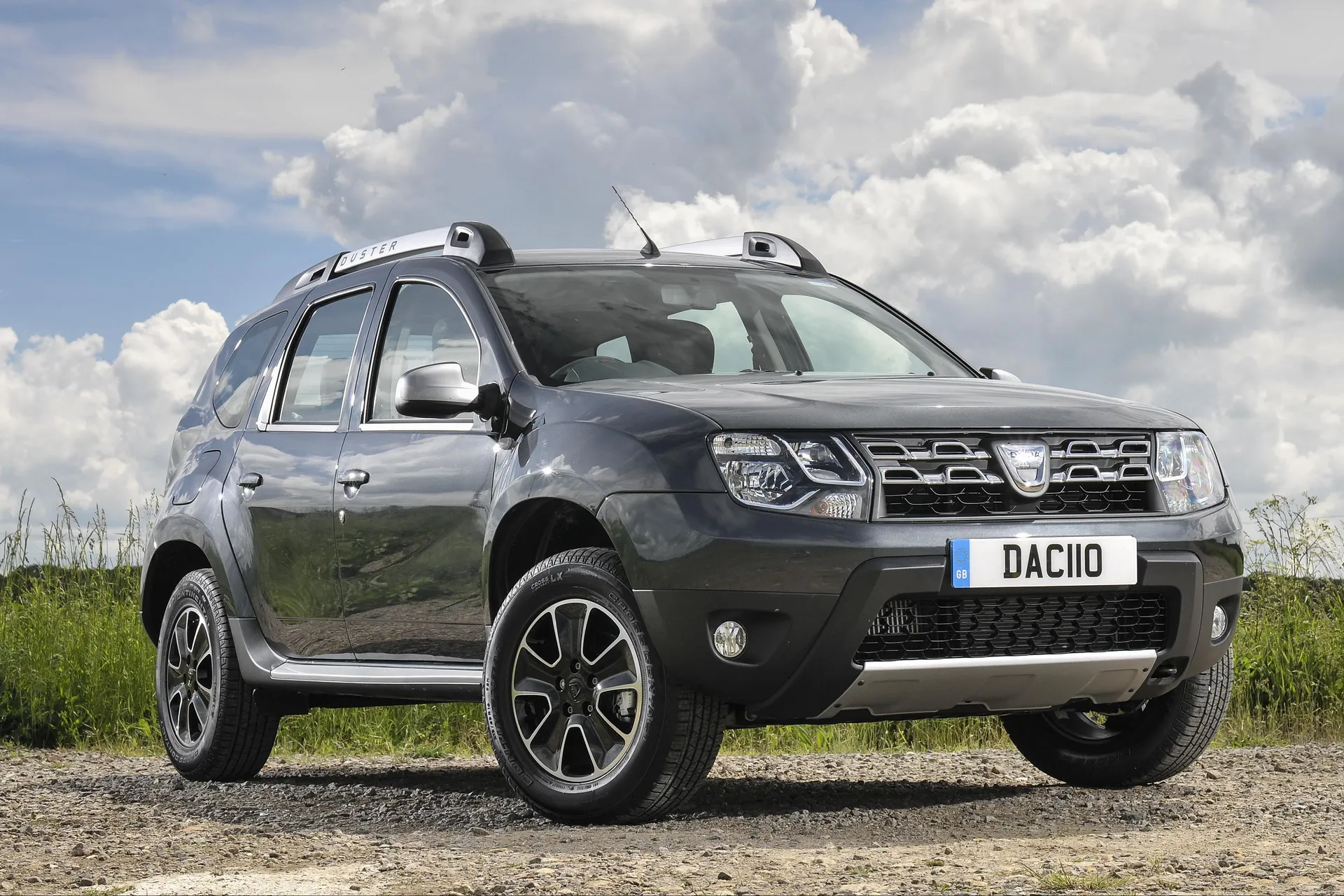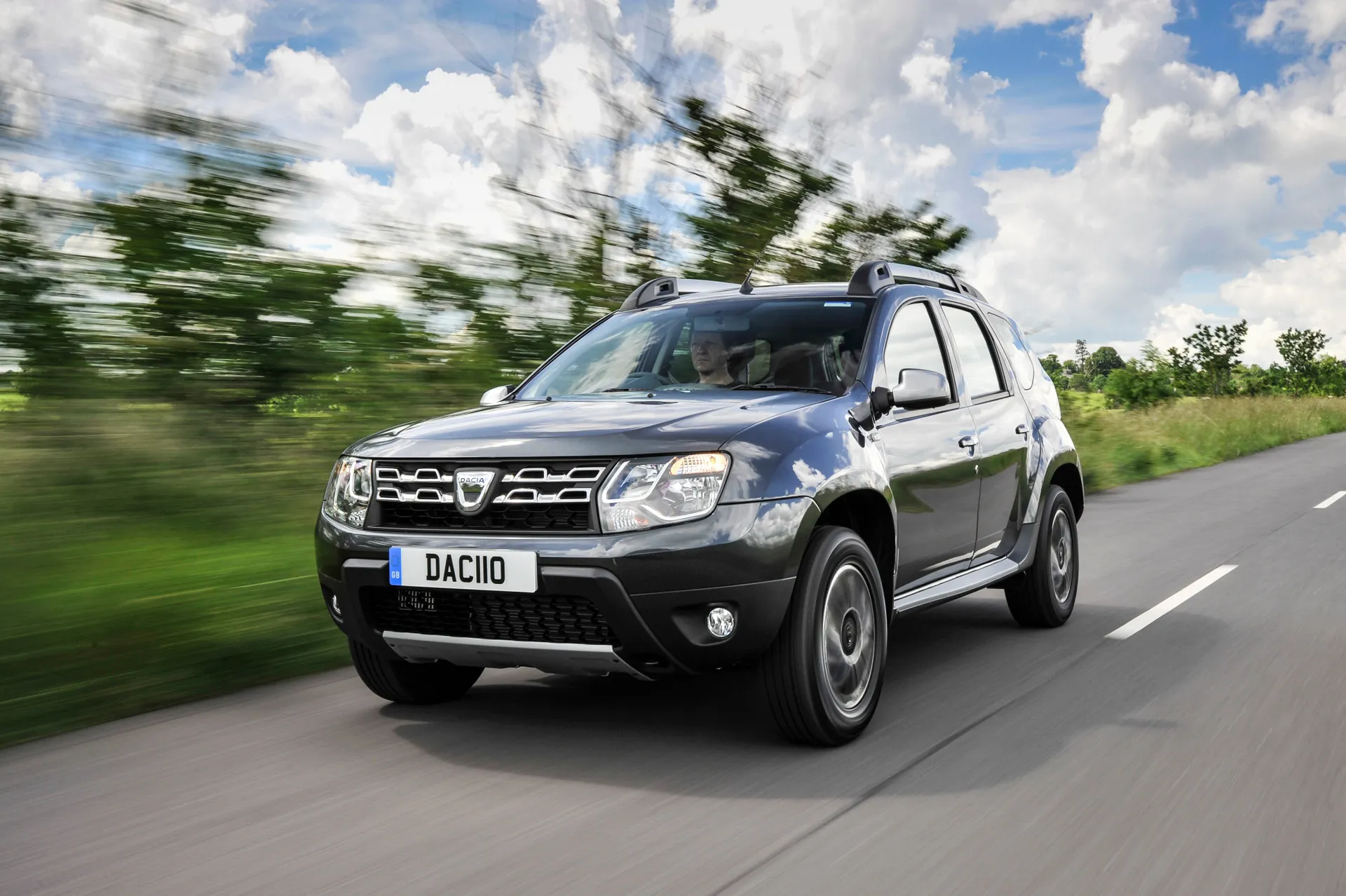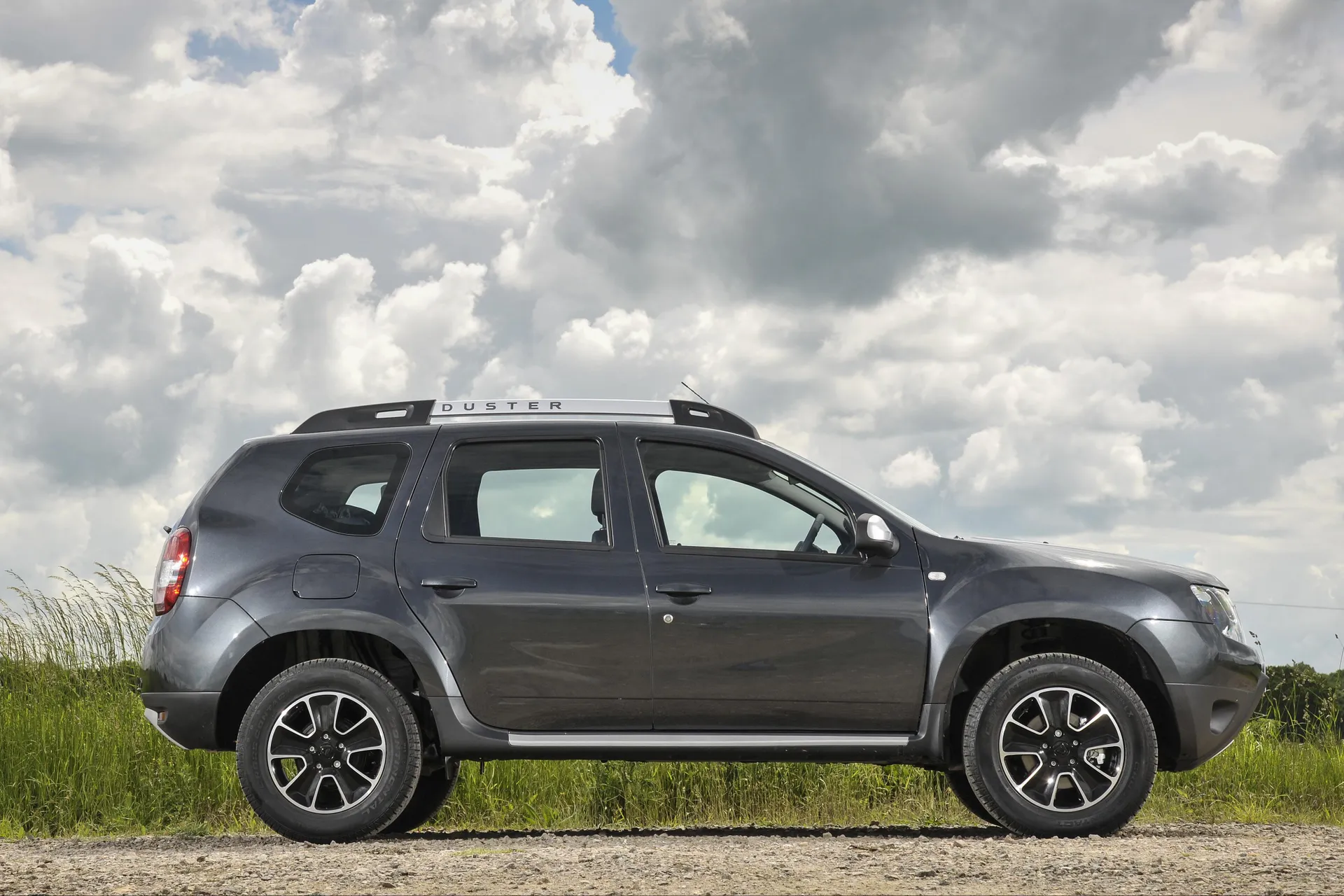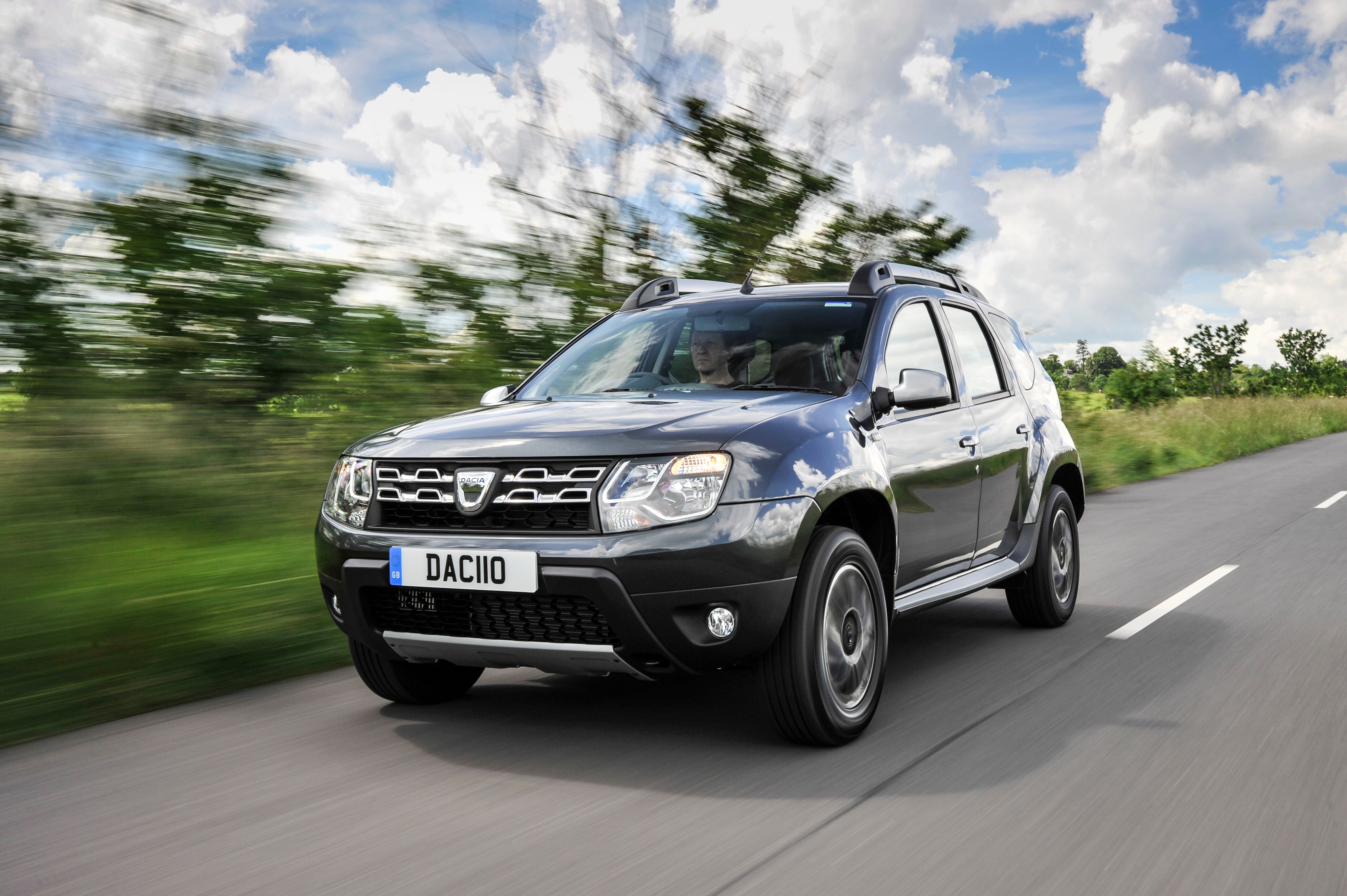Dacia Duster (2012-2018) Review
Written by Andrew Brady
Quick overview
Pros
- Spacious cabin with seating for five adults
- Large boot with a low loading lip
- Exceptional value for money, especially when buying used
Cons
- Questionable cabin quality with some very cheap finishes
- Lacks the safety credentials of more expensive rivals
- Cheapest models lack basic equipment
Overall verdict on the Dacia Duster
"In this Dacia Duster review we are looking at one of the cheapest cars ever sold in the UK - and certainly the cheapest SUV - which means it has great potential as a used buy too. Designed to be spacious and practical as well as excellent value, the Duster is short on thrills but makes a good deal of sense."

What’s the catch? That’s the first question you might ask when looking at prices of the Dacia Duster. When so many car manufacturers appear to be pushing further upmarket, Dacia remains a resolutely budget brand.
Which makes the Duster all the more refreshing. What it lacks in badge appeal and finesse, it more than makes up for in terms of space, practicality and value for money. Drive a Dacia Duster and you can show two fingers to the motoring establishment. Metaphorically speaking, of course.
It’s almost without direct rivals, with a size that pitches it against cars like the Nissan Qashqai and Ford Kuga, but a price tag that’s more akin to the likes of the Hyundai i10 and Peugeot 108.
Although there’s a limited range of engines, each one is well up to the task of powering the Duster, with the 1.5 dCi diesel a particularly impressive performer. A blend of fuel efficiency, low CO2 emissions and punch make it the engine of choice, unless you spend a lot of time in the city.
For a car at the budget end of the market, the Duster is also surprisingly comfortable, with an ability to smooth out all but the worst imperfections in the road. For seriously tough conditions, a four-wheel-drive Duster is available. Make no mistake, the Duster 4x4 is up to most off-road challenges.
There’s space inside for five adults, which isn’t something you can always say about cars of this size, with the room in the cabin not coming at the expense of luggage capacity. The boot is of a good shape, while the low lip and wide tailgate make loading a doddle.
So what is the catch? Well the basic Duster Access is about as generous as Scrooge before he saw the light, while even the Ambiance version isn’t exactly loaded like Santa’s sack.
Top trim levels offer a decent specification, but the more you spend on the Duster, the less attractive it gets. The idea of a Duster with no radio or air conditioning might sound fun for three minutes, but over the course of a three-year finance deal, we suspect the novelty will have worn off.
The first-generation Dacia Duster of 2012 to 2018 also lacks the kind of safety equipment we take for granted in 2020, while the provision of in-car entertainment and connectivity is at least a generation behind what you might expect and demand.
Not that any of this detracts from what is a thoroughly appealing, almost charming vehicle. We love its no-nonsense approach to motoring. It’s the John Smith’s bitter of the car world – just don’t try doing a ‘running bomb’ into your nearest municipal swimming pool. ’Ave it.
Looking for a used car for sale? We've got 100s of Dacia Approved Used Cars for Sale for you to choose from, including a wide range of Dacia Duster models for sale. If you're looking for the newer version, you need our Dacia Duster review.
Is the Dacia Duster right for you?
If you want a practical and spacious SUV for the price of a city car, the Dacia Duster is the vehicle for you. Headline-grabbing prices when new translate to seriously tempting deals on used Dusters, making this one of the best value second-hand cars in the UK.
It’s not just about the price. Proven Renault parts provide some reassurance, while seating for five and a large boot make the Duster a terrific choice for growing families. It’s like a giant Tonka toy, with proper go-anywhere spirit, especially if you opt for a four-wheel-drive version.
The Duster might not have a premium badge, but if you shop in Lidl or Aldi you’ll know that the feeling of getting more for your money can be quite satisfying. Buy a Dacia and you’ll have more money left for the things that are important to you.
What’s the best Dacia Duster model/engine to choose?
We’re not keen on sitting on the fence – not least because it’s quite uncomfortable – but we’d recommend one of two engines. If you spend a lot of time on the motorway, carrying large loads or towing, the 1.5 dCi diesel is the best option.
It’s a tried and tested unit found in a range of Dacia, Renault and Nissan models, offering a superb balance of performance and fuel economy. However, if you spend most of your time in the city or doing short trips, the 1.2-litre TCe unit is cheaper than the diesel and offers respectable fuel economy. You’ll also pay less at the pumps and have no concerns about diesel particulate filters (DPF).
Trim levels have changed during the car’s lifetime, but we’d recommend the mid-spec Ambiance at the very least for the best blend of price and equipment. Laureate was the top trim on early models, but was more mid-range by the time production had finished, so it’s worth a look.
What other cars are similar to the Dacia Duster?
It would be a stretch to say that the Dacia Duster is a unique proposition, but it does occupy a niche in the UK. From a price perspective, it rivals city cars and budget superminis.
Practically speaking, the Dacia Duster is a rival to the Nissan Qashqai, but value-driven cars like the SsangYong Tivoli, MG ZS and Suzuki Vitara also count as competitors. For off-road antics, the Duster can count the likes of the Fiat Panda 4x4 and Suzuki Jimny as rivals when the going gets a bit ‘Billy Ocean’. These budget mountain goats can climb nearly every mountain and ford the majority of streams.
Comfort and design: Dacia Duster interior
"In a world of haute cuisine and posh plonk, the Dacia Duster is a steak and kidney pie washed down with a pint of ale. Nothing fancy and nothing OTT – just a straightforward and no-frills approach to comfort and design."

You sit high in the Duster, which gives you a commanding view of the road ahead, and while the seats are comfortable, it’s worth noting that the driver’s seat and steering wheel in the basic model cannot be adjusted for height.
In truth, the basic Access version is best avoided unless you enjoy slumming it. There are just two things listed under ‘Comfort and Convenience’ in the brochure: a boot light and four-speed heating and ventilation with air recirculation. We’ve sat in Belarusian bus shelters with more creature comforts.
The dashboard design is functional, bordering on basic. It looked dated in 2012, so it’s practically pensionable today. Not that this matters – the dials are clear and logical, while the switches and buttons are easy to understand. It’s not all doom, gloom and bus shelters. In an effort to bridge the gap between the Duster and other SUVs, Dacia rolled out a number of special editions and more ‘premium’ trim levels.
Leather seats were an option on some models, while the SE Summit offered orange trim upholstery and burnt orange air vent surrounds. It’s like a drizzle of jus on your steak and kidney pie. Or something.
Quality and finish
Everything we’re about to say about the quality and finish should be viewed in the context of the price. Approach the Duster expecting to find the fit and finish of an Audi or a Mercedes-Benz and you will be disappointed. But let’s be honest: you didn’t expect that level of quality, did you?
Instead, you get a cabin that’s fit for purpose, built to a price and, evidence would suggest, hard-wearing. The plastics scratch easily and feel as reassuring as the capsule you’ll find in a Kinder Surprise. We wouldn’t recommend cracking open the Duster’s dashboard, unless you like the look of wires, glue and more plastic.
Touch points like the inner door handles, steering wheel, handbrake and luggage cover feel cheap, so it’s impossible to avoid the impression that you’re driving something at the budget end of the market.
However, buy a Duster with such ‘luxuries’ as a leather steering wheel and grey interior accents and it all becomes a tad more pleasant. Spending too much on a Duster kind of defeats the object of buying a cheap car, but it will be easier to live with over the course of a finance contract.
Infotainment: Touchscreen, USB, nav and stereo in the Dacia Duster
The Dacia Duster is the kind of car that, could it speak, would bemoan the use of words like ‘infotainment’. You have to venture a long way up the trim ladder to find something resembling an infotainment system, even on the very latest versions of the first-generation car.
The base-spec Duster Access lacks any form of audio equipment, so we hope your passenger’s singing voice is up to scratch. Move up a level and you’re treated to a DAB/FM/AM tuner, although you also get Bluetooth and USB connectivity.
A 7.0-inch MediaNav touchscreen infotainment system is standard on the top trim models (or optional on others) and features navigation, a radio, telephone, music and a reversing camera – but still feels like it’s from a previous generation car. It also sits too low in the centre console, making it difficult to operate on the move.
To say it’s better than nothing feels a little like damning the Duster with faint praise, but without the benefit of Apple CarPlay or Android Auto, the infotainment system is barely adequate. We’d even recommend opting for a lower spec model and fitting an aftermarket audio unit.
Space and practicality: Dacia Duster boot space
After the slightly negative vibes of the quality and infotainment system, this is the point at which the Dacia Duster hauls itself off the floor and lands a killer blow. Put simply, the Duster’s space and practicality is a knockout punch to the opposition.
You climb up to get into a Duster, which lends the Dacia an unlikely level of prestige. You quite literally look down on humble saloons and hatchbacks. There’s also plenty of room up front, so you can lord it up while your passenger sings the greatest hits of Billy Ocean. Give yourself some Popmaster points if you can name ‘three in 10’.
Once your rear-seat passengers have, ahem… got into the car, they’ll find space for three adults, which isn’t a given in cars of this size. There are ISOFIX points on the outer seats, so you can fit Group 0, 1, 2 and 3 child car seats without a problem.
A small but significant point is the size of the rear side windows, which serve to create a light and airy cabin. Too many manufacturers prioritise form over function, with sloping roof lines and styled windows creating claustrophobic interiors, especially in the rear.
Front-wheel-drive Dacia Dusters boast a 475-litre boot, which is pretty good for a car of this size. For context, a Nissan Qashqai offers 430 litres, while you’ll find 375 litres in a Ford Focus hatchback. Note: the boot in four-wheel-drive versions of the Duster is smaller (443 litres with a puncture repair kit, or 408 with a spare wheel).
The Duster’s tailgate creates a tall and wide opening, with loading made easier thanks to the low loading lip. All versions except the entry-level Access model get a 60/40 split folding rear bench, although the seats don’t lie entirely flat.
There’s a reasonable amount of storage space up front, with door pockets large enough for a bottle of water, two cupholders in front of the gear stick, a good size glovebox and a tray atop the dashboard. Storage for oddments is a bit limited in the back, but high-spec models get map pockets on both front seatbacks. Control your excitement.
The Dacia Duster's dimensions are 4315mm in length, 2000mm wide and 1625mm height.
Handling and ride quality: What is the Dacia Duster like to drive?
"Remember that point we made about Tonka toys? Have that in mind when we describe the driving experience. Straight line comfort is the Duster’s biggest strength. In fact, it all feels very French, which is hardly surprising given its Renault underpinnings."

The ride quality isn’t pillow-soft, but the Duster smooths out Britain’s pockmarked road surfaces, with its cabin feeling nicely insulated from what’s going on beneath the wheels. However, its greatest strength is also one of the Duster’s biggest weaknesses, because this particular Tonka toy isn’t too keen on corners. There’s a fair amount of lean, with the Duster feeling a bit cumbersome through the bends.
It doesn’t help that the steering wheel doesn’t feel attached to the wheels – there’s almost no communication between the two. You will get used to it, but don’t approach the Duster with hopes of finding a precision instrument. While the modern breed of SUVs are genuine rivals for their less lofty counterparts, the Duster harks back to days of old.
Not that this really matters. Thanks to tyres with fat sidewalls and alloy wheels no larger than 16 inches, the Duster is as comfortable as that pair of shoes you wear for gardening and walking the dog. Fashion can wait for when you meet your mates for a drink on a Friday night.
What engines and gearboxes are there in the Dacia Duster?
The Dacia Duster was launched with a choice of two Renault engines. A 1.6-litre 16v petrol was offered on the entry-level Access trim, while the familiar 1.5 dCi diesel powered the Ambiance and Laureate models. Throughout the Duster’s life, the 1.5 dCi 110 was the engine of choice, thanks to its excellent fuel economy, CO2 emissions and performance. The 0-62mph time is a leisurely 11.8 seconds, but with peak torque at 1,750rpm, the 1.5 dCi isn’t short of pulling power.
On paper fuel economy of 64.2mpg in the front-wheel-drive version is likely to result in a real world figure of 50mpg-plus, depending on your driving style. There’s a 4.0mpg penalty for choosing a four-wheel-drive version.
A 1.2 TCe 125 turbocharged petrol engine was added to the second-generation Duster range mid-way through its life. It helped to close the gap between the petrol and diesel engines, and is the unit to opt for if you spend most of your time doing short journeys. The TCe 125 delivers a claimed 46.3mpg in the front-wheel-drive Duster, or 44.1mpg in the 4x4.
Later models also came with an all-new 1.6-litre 16v SCe 115 petrol engine offering improved acceleration and better fuel economy. We still prefer the other two units, mind.
Most models are fitted with a manual gearbox – five-speed on the SCe 115 and six-speed on the TCe 125 and dCi 110 – although a six-speed dual-clutch automatic transmission is an option on the front-wheel-drive Duster diesel.
Refinement and noise levels
Having spent the last couple of minutes extolling the virtues of the diesel engine, we’re about to chuck a fly in the ointment. The 1.5 dCi is as old as the hills and isn’t the last word in refinement. It’s rather vocal at idle or under heavy load, which might have the effect of drowning out your passenger’s singing voice. You can decide whether or not this is a good thing.
The 1.6-litre 16v unit also lacks refinement, especially if you’re accustomed to the lazy acceleration of a turbocharged petrol engine. Peak power is at the top of the rev range, so you’ll have to work it hard to get the best from it. It also feels noisy at motorway speeds and you’ll be craving an additional sixth gear.
You could find that the 1.2 turbo provides the best compromise, especially as it offers the benefit of a sixth gear. This makes it the best petrol engine for motorway driving, but it can’t match the long-leggedness of the diesel.
There’s a fair amount of road and wind noise, which is especially apparent on the motorway. It’s also a significant problem in the Access model because you can’t crank up the volume of the (non-existent) stereo to mask the noise.
Safety equipment: How safe is the Dacia Duster?
The Dacia Duster was awarded a middling three stars for safety when it was crash-tested by Euro NCAP in 2011. Scores of 74 percent and 78 percent for adult and child occupant protection were pretty decent, but 28 percent and 29 percent for pedestrian safety and safety assistance systems were well below par.
Part of the Duster’s problem is its lack of driver assistance tech. The Duster is no less safe today than it was in 2011, it’s just that the technology has moved on and the Euro NCAP test is more stringent.
Perhaps we’re cutting the Dacia Duster too much slack. Emergency brake assist, driver and passenger airbags, front airbags and two ISOFIX points isn’t a great arsenal when viewed in the context of key rivals. It’s also not great when the brochure lists a high-level third rear brake light as a core feature.
It’s worth noting that only the four-wheel-drive versions come with a spare wheel – the others have a tyre inflation kit. A spare wheel is an option across the range, so see if the Dacia Duster you’re looking at has one in the boot. A reverse parking camera is only standard on the top models, optional on mid-range models and not available on low-spec versions. In fairness, visibility is excellent, but a camera can be useful when the boot is full of gear.
MPG and fuel costs: What does a Dacia Duster cost to run?
"The Dacia Duster was at its most economical just before it was replaced by the new model. Economy honours go to the front-wheel-drive 1.5 dCi, which offers a claimed 64.2mpg on a combined cycle."

This drops to 62.8mpg in the automatic version and 60.1mpg in 4x4 guise. The 1.25 TCe offers a claimed 46.3mpg in front-wheel-drive models, or 44.1mpg if you opt for four-wheel drive. Finally, the 1.6 SCe could return 44.1mpg or 41.5mpg, depending on whether you opt for front- or four-wheel-drive versions.
Remember, these are the old NEDC figures, so they won’t be as accurate as those obtained using the latest WLTP fuel economy cycle.
How reliable is a Dacia Duster?
The Dacia Duster scored a highly impressive 9.67 out of 10 for reliability in the HonestJohn.co.uk Satisfaction Survey - higher than many cars from more prestigious brands costing thousands more.
Better yet, Dacia came first overall in the same survey, making it the UK's best-rated car brand. Owners have high marks for ease of use, fuel economy and low repair costs as well as reliability. High praise indeed.
Insurance groups and costs
Insurance groups range from eight to 12, depending on the engine and trim level. It’s interesting to note that four-wheel-drive versions of the 1.6 SCe are a group lower than the front-wheel-drive versions, with insurance companies recognising the benefits of all-weather traction and grip.
The Nissan Qashqai’s lowest insurance group is 13, while the Suzuki Vitara’s is 11. This just goes to prove that the Duster should be a relatively inexpensive car to run.
VED car tax: What is the annual road tax on a Dacia Duster?
The Vehicle Excise Duty (VED) tax bands changed throughout the first-generation Duster’s lifecycle, but the very latest models incur a flat rate of £165 from the second year.
Costs are different for Dacia Duster models registered between the start of production and 31 March 2017. The lowest you’ll pay is £30 a year for a front-wheel-drive 1.5 dCi. Meanwhile, the maximum rate is £215.25 for a four-wheel-drive 1.6 SCe. Put simply, to pay the least amount of tax, buy a pre-2017 Duster diesel.
How much should you be paying for a used Dacia Duster?
"There’s good news and bad news. Starting with the positive vibes: the Dacia Duster is one of the cheapest relatively new SUVs you can buy. High-mileage examples start from around £3000, regardless of trim, engine or drivetrain."

The bad news isn’t bad news as such, it’s just that the Duster isn’t quite the bargain on the used car market as when new. It tends to offer strong residual (resale) values, so it might make sense to spend a little extra on a new or nearly-new example with its original warranty intact. A post-facelift 2016 example could be yours for as little as £6000, while 2017 models start from £7500.
Trim levels and standard equipment
Trim and equipment levels varied throughout its lifespan, but the Dacia Duster Access was always the base model. Dacia Duster Ambiance and Laureate were the other offerings at launch, but these were joined by the Dacia Duster Prestige and SE Summit before the Duster made way for the new version.
Also look out for special editions and packs, including Black and Laureate Prime.
Dacia Duster Access and Ambiance models left the factory without air conditioning, which makes them hard to recommend. This makes Laureate the realistic entry-level model, as it offers the basics required for the modern motorist. You’re a modern motorist, aren’t you?
Don’t forget the SE Summit, which offers diamond-cut alloy wheels, exclusive grey metallic paint, wheelarch extensions and the aforementioned burnt orange air vent surrounds. It’s arguably the best looking first-generation Duster.
Ask the heycar experts: common questions
Which Dacia Duster model is best?
Is the Dacia Duster a safe car?
Can you get an automatic Dacia Duster?
Get our latest advice, news and offers
Keep me updated by email with the latest advice, news and offers from heycar.
By submitting you agree to our privacy policy



